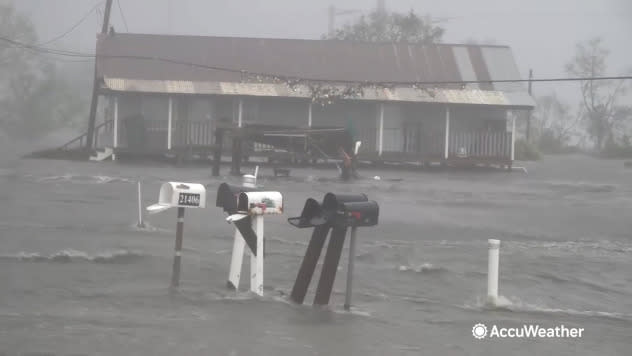Hurricane that hit New Orleans was stronger than previously thought
The official start of the 2021 Atlantic hurricane season is less than three weeks away, but last year's hurricane season is still setting records.
The 2020 hurricane season was one that will not soon be forgotten with a record-setting 30 named storms across the Atlantic basin, more than double the historical average and bypassing the 2005 season which featured 28 named storms.
After the conclusion of each hurricane season, the National Hurricane Center (NHC) pours through all of the data collected throughout the season and re-analyzes every storm. And on Tuesday, the NHC made an announcement about one of the final storms of the 2020 season.
On Oct. 28, 2020, Hurricane Zeta roared ashore in southeast Louisiana with the eye of the storm eventually tracking directly over New Orleans.
Shortly before making landfall, the Hurricane Hunters flew through the core of the cyclone and reported maximum sustained winds of 110 mph (95 knots). This is considered to be a high-end Category 2 hurricane on the Saffir-Simpson wind scale.
However, Zeta continued to strengthen in the two hours that transpired between the time that the plane flew through the storm and when landfall occurred.
 |
Hurricane Zeta making landfall in southeastern Louisiana on Oct. 28, 2020. (Image/NOAA) |
During this small window, the NHC re-analysis found that Zeta's pressure fell an additional 3 millibars (0.09 of an inch of mercury) and that the maximum sustained winds increased to 115 mph (100 knots).
"While a 5-knot change is typical for post-analysis best track intensity changes, this increase in Zeta's peak intensity crosses the threshold from Category 2 to Category 3," the NHC explained.
This upgrade makes Zeta the seventh major hurricane of the 2020 season, which ties the 2005 season for having the highest number of major hurricanes in a single season.
With a landfall of Oct. 28, Zeta now holds the record for the latest U.S. landfall of a major hurricane, according to Philip Klotzbach, a meteorologist at Colorado State University who specializes in tropical meteorology.
The Tampa Bay Hurricane of 1921 held the previous record for the latest U.S. landfall of a major hurricane. That hurricane moved ashore on Oct. 25.
 |
The Mercedes-Benz Superdome in New Orleans as the eye of Hurricane Zeta moved overhead on Wednesday, Oct. 28, 2020. (NOLA Ready) |
The upgrade to a major hurricane may change the way that some perceive the 2020 season as a whole, but the overall impacts from the storm remain the same.
"These Category 3 sustained winds were likely experienced over only a very small area at and near the coast near the landfall location, and this change in the estimated landfall intensity is of little practical significance in terms of the impacts associated with the storm there," the NHC added.
 |
Windswept floodwaters inundate mailboxes and a coastal home near Cocodrie, Louisiana, where Hurricane Zeta made landfall on Oct. 28, 2012. (AccuWeather) |
Zeta led to $4.4 billion in damage across the U.S., according to the NOAA National Centers for Environmental Information. Most of the damages occurred in the states closest to where it made landfall.
The hurricane is also to blame for five direct deaths and at least 75 injuries across Louisiana, Mississippi, Alabama and Georgia.
CLICK HERE FOR THE FREE ACCUWEATHER APP
This is not the first time that a post-season analysis has altered the statistics of the 2020 Atlantic Hurricane season.
On April 20, 2021, the NHC announced that Tropical Storm Gamma briefly strengthened into a hurricane just as it was making landfall along the Yucatan Peninsula on Oct. 3, 2020.
An even bigger post-season analysis cemented Hurricane Michael's spot in history after it devastated the Florida Panhandle in 2018.
At the time of landfall, the NHC said that it was an intense Category 4 hurricane. However, months later in a post-storm analysis, the NHC announced that Michael achieved Category 5 status as it was moving ashore.
Because of this post-storm analysis, Michael became just the fourth storm to make landfall in the U.S. as a Category 5 hurricane. The previous hurricanes to hit the U.S. at Category 5 strength were Andrew in 1992, Camille in 1969 and the Labor Day Hurricane in 1935.
Keep checking back on AccuWeather.com and stay tuned to the AccuWeather Network on DirecTV, Frontier, Spectrum, FuboTV, Philo, and Verizon Fios.



